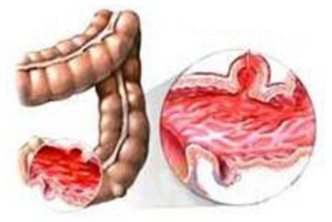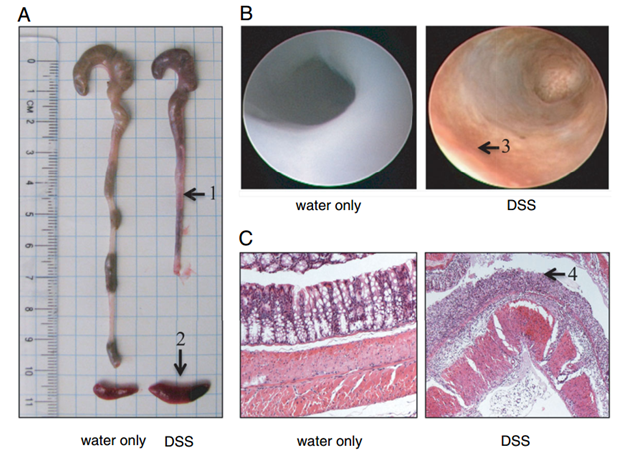Inflammatory Bowel Disease Models
Inflammatory bowel disease (IBD) is a chronic intestinal inflammatory disorder which encompasses Crohn's disease (CD) and ulcerative colitis (UC). It is well known that genes, immune and environmental factors play a vital role in the occurrence of IBD. At present, the prevalence of IBD is over 0.3% worldwide. And about 70 different kinds of animal models have been established to research IBD so far, which are mainly divided into chemically induced model, genetically engineered model, cell-transfer colitis model and congenial mutant model.
Creative Bioarray focuses on drug research and development services and helps customers explore novel therapeutic options and understand the pathogenesis of IBD by IBD models.
 Figure. 1. Colitis
Figure. 1. Colitis
Creative Bioarray provides you with inflammatory bowel disease models including but not limited to:
- Chemically induced model
- Dextran Sulfate Sodium (DSS) induced model
- TNBS induced model
- Oxazolone induced model
- Indomethacin induced model
- Genetically engineered models
- IL-10 knockout colitis model
- Mdr1a knockout model
- SAMP1/Fc mouse model
- Adoptive T cell transfer induced colitis model
- Anti-CD40 antibody induced colitis model
Our capabilities
- We utilize Inflammatory bowel disease models to test the efficacy of drug candidates targeting IBD.
- We assess the severity of IBD through clinical analysis including weight loss, diarrhea and occult blood in stool.
- We evaluate various cytokines through IHC, ELISA, etc.
Assays available
- Clinical analysis
- Histopathological evaluation
- Analysis of mRNA and protein levels
- Cytokine/chemokine analysis
- Immunohistochemistry
With extensive experience in the field of IBD, we are confident to help you to overcome any upcoming challenges. Our experts are fully capable of customizing our protocols and assays to meet your specific needs. With our help, we wish to facilitate your research with high efficiency.
Study examples
 Figure. 2. DSS-induced intestinal inflammation in mice. Eight-week-old C57BL6 mice were given 2.5% DSS in drinking water for 7 days. Control mice were given water only. On day 8, mice were sacrificed and monitored for colitis. (A) Gross picture of colons. (B) Endoscopic examination of colons. (C) H&E-stained colonic sections. Arrows indicate: (1) shortened and bleeding colons, (2) enlarged spleen, (3) superficial inflammation, (4) epithelial erosion and immune cell infiltration in DSS-treated mice.
Figure. 2. DSS-induced intestinal inflammation in mice. Eight-week-old C57BL6 mice were given 2.5% DSS in drinking water for 7 days. Control mice were given water only. On day 8, mice were sacrificed and monitored for colitis. (A) Gross picture of colons. (B) Endoscopic examination of colons. (C) H&E-stained colonic sections. Arrows indicate: (1) shortened and bleeding colons, (2) enlarged spleen, (3) superficial inflammation, (4) epithelial erosion and immune cell infiltration in DSS-treated mice.
Quotation and ordering
If you have any special needs or questions regarding our services, please feel free to contact us. We look forward to cooperating with you in the future.
Reference
Chassaing B , Aitken J D , Malleshappa M , et al. Dextran Sulfate Sodium (DSS)-Induced Colitis in Mice.[J]. Curr Protoc Immunol, 2014, 104:Unit 15.25.
For research use only. Not for any other purpose.
Disease Models
- Oncology Models
-
Inflammation & Autoimmune Disease Models
- Rheumatoid Arthritis Models
- Glomerulonephritis Models
- Multiple Sclerosis (MS) Models
- Ocular Inflammation Models
- Sjögren's Syndrome Model
- LPS-induced Acute Lung Injury Model
- Peritonitis Models
- Passive Cutaneous Anaphylaxis Model
- Delayed-Type Hypersensitivity (DTH) Models
- Inflammatory Bowel Disease Models
- Systemic Lupus Erythematosus Animal Models
- Oral Mucositis Model
- Asthma Model
- Sepsis Model
- Psoriasis Model
- Atopic Dermatitis (AD) Model
- Scleroderma Model
- Gouty Arthritis Model
- Carrageenan-Induced Air Pouch Synovitis Model
- Carrageenan-Induced Paw Edema Model
- Experimental Autoimmune Myasthenia Gravis (EAMG) Model
- Graft-versus-host Disease (GvHD) Models
-
Cardiovascular Disease Models
- Surgical Models
- Animal Models of Hypertension
- Venous Thrombosis Model
- Atherosclerosis model
- Cardiac Arrhythmia Model
- Hyperlipoidemia Model
- Doxorubicin-induced Heart Failure Model
- Isoproterenol-induced Heart Failure Model
- Arterial Thrombosis Model
- Pulmonary Arterial Hypertension (PAH) Models
- Heart Failure with Preserved Ejection Fraction (HFpEF) Model
-
Neurological Disease Models
- Alzheimer's Disease Modeling and Assays
- Seizure Models
- Parkinson's Disease Models
- Ischemic Stroke Models
- Acute Spinal Cord Injury (ASCI) Model
- Traumatic Brain Injury (TBI) Model
- Hypoxic-Ischemic Encephalopathy (HIE) Model
- Tourette Syndrome (TS) Model
- Amyotrophic Lateral Sclerosis (ALS) Model
- Huntington's Disease (HD) Model
- Intracerebral hemorrhage (ICH) Models
- Schizophrenia Model
- Pain Models
-
Metabolic Disease Models
- Type 1 Diabetes Mellitus Model
- Type 2 Diabetes Mellitus Model
- Animal Model of Hyperuricemia
-
Nonalcoholic Fatty Liver Disease Model
- High-Fat Diet-Induced Nonalcoholic Fatty Liver Disease (NAFLD) Model
- Methionine and Choline Deficient (MCD) Diet-Induced Nonalcoholic Fatty Liver Disease (NAFLD) Model
- Gubra-Amylin NASH (GAN) Diet-Induced Nonalcoholic Fatty Liver Disease (NAFLD) Model
- Streptozotocin (STZ) Induced Nonalcoholic Fatty Liver Disease (NAFLD) Model
- High Fat Diet-Induced Obesity Model
- Diabetic Foot Ulcer (DFU) Model
- Liver Disease Models
- Rare Disease Models
- Respiratory Disease Models
- Digestive Disease Models
-
Urology Disease Models
- Cisplatin-induced Nephrotoxicity Model
- Unilateral Ureteral Obstruction Model
- 5/6 Nephrectomy Model
- Renal Ischemia-Reperfusion Injury (RIRI) Model
- Diabetic Nephropathy (DN) Models
- Passive Heymann Nephritis (PHN) Model
- Adenine-Induced Chronic Kidney Disease (CKD) Model
- Kidney Stone Model
- Doxorubicin-Induced Nephropathy Model
- Orthotopic Kidney Transplantation Model
- Orthopedic Disease Models
- Ocular Disease Models
- Skin Disease Models
- Infectious Disease Models
- Otology Disease Models